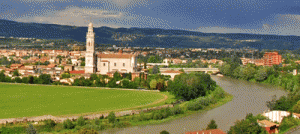The municipality of Pescantina is located west-north-west of the city of Verona

TERRITORY OF PESCANTINA
Surrounding municipalities: Bussolengo, Pastrengo, San Pietro in Cariano, Sant’Ambrogio di Valpolicella, Verona
Altitude: 80 m s.l.m. – Population: 15.773 – Inhabitants name: pescantinesi
HISTORY OF PESCANTINA
There are no prehistoric prooves about the origin of the settlement, but there is confirmation that would place Pescantina and other places in the municipal area in Roman times. There are many examples of this period: funeral stones, altars and the lid of a sarcophagus which is kept in the church of San Lorenzo. Both in Roman era that in the next one whole the lower Valpolicella overlaid great strategic importance, and in the Middle Ages villages of Arcè, Saint Lucia, Settimo and Pescantina are included in “Provinianensis Vallis”, one of the two areas in wich Valpolicella area was divided, the other one was the “vallis Veriacus” that today corresponds to Negrar valley. Between the years 1404 and 1405 Pescantina was overwhelmed by the war between Carrara and the Venetians in the course of which it was built and destroyed a country house (between Arcè and Pescantina). Under Venetian rule developed trade on the river Adige bringing the country wealth and fame. Pescantina for more than two centuries it was the pivot of navigation enjoying particularly well, but not saved from the terrible plague of 1576 and 1630 decimated a large part of its inhabitants. Later, toward the end of 1700, came the Napoleonic armies that brought devastation, looting and war episodes that led over time to the decline in traffic on the river. Under Austrian domination Pescantina was not touched by war but trade water had a meltdown, even supplanted by the arrival of the train (the railway between Verona and Trento was inaugurated in 1859).
LOCAL PRODUCTS OF PESCANTINA
Peaches,
FRACTIONS OF PESCANTINA
Settimo: This village owes its name to the seventh milestone located along the Roman road Claudia Augusta that went from here. In the past and a vibrant harbor and there was a ferry that connected the two banks of the bridge was replaced in 1950 and still exists today. Holiday resort of the noble families who built mansions surrounded by lush gardens.
Arce: Of ancient origin in this fraction was found in the Roman stone, the streets of his village hidden art treasures, coats of arms and sacred images.
Santa Lucia: It certainly of ancient origin Saint Lucia also has a valley intensively cultivated with peach orchards, and there are many factories for the processing of marble. There were two mills in the nineteenth century that were used for the milling of cereals.
Ospedaletto and Balconi: Two young hamlets that have developed recently, thanks to the state of the Brenner. Ospedaletto is located around the complex of Villa Quaranta and Balconies developed the crossroads between the Brenner and the provincial government of Valpolicella
